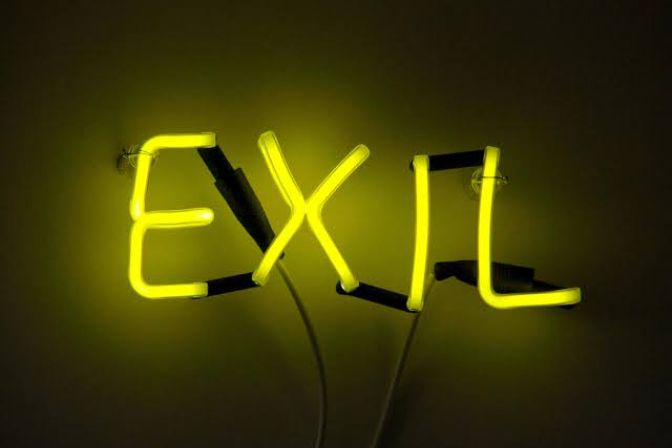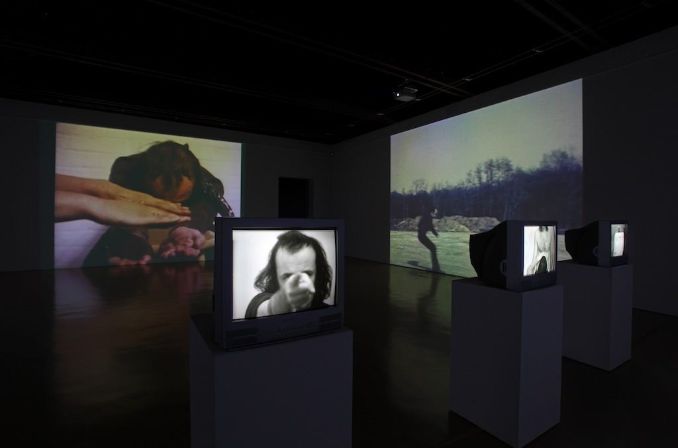Onward! Onward! Onward! by Jiang ZhiJiang Zhi (b. 1971, Yuanjiang, China) is widely regarded as one of the most versatile and thought-provoking Chinese artists of his generation. His multifaceted approach to art spans across a wide range of media, including photography, painting, video, installation, and even literary publishing. His works, often deeply engaged with contemporary social and cultural issues, provide a platform for exploring the complexities of modern consciousness, especially in the context of China’s rapidly changing social landscape. His art plays with perceptions of reality, pushing the boundaries of digital imagery and manipulating visuals to challenge viewers’ understanding of the present and the mental conceptions they bring to it.
In Onward! Onward! Onward!, Jiang Zhi’s work takes the form of a large-scale installation, and was featured as part of the group exhibition There is no ‘I’ in Team. The exhibition served as a unique opportunity to showcase the works of an extraordinary and vibrant new generation of Chinese artists from mainland China, Hong Kong, Taiwan, and Macau, all of whom are leading the charge in the global contemporary art scene, particularly through moving image, sound, and installation art. These artists represent a prolific wave of creation, reflecting the growing power and influence of Chinese culture and artistic production on the global stage.
The work invites viewers to step into a complex narrative that challenges our understanding of space, social structures, and individual versus collective identity. In typical Jiang Zhi fashion, the installation works to create an experience that blurs the line between personal and universal, utilizing a range of sensory and visual stimuli to push the boundaries of human perception. Jiang’s art is fundamentally concerned with the intersection of poetics and sociology, which allows his works to function as both philosophical reflections and commentaries on the social and political climates of contemporary China.
One of Jiang’s most striking characteristics as an artist is his ability to engage deeply with personal and collective experiences. His works often speak to the tensions between individual desires and the societal structures that shape them. Through innovative use of digital manipulation and hi-tech imagery, he explores and challenges the conditions of modern consciousness, drawing attention to the ways technology shapes the way we see and understand the world.
A key example of Jiang Zhi’s approach is his photograph of the Chongqing House, widely known as the “House of Nails”. The house, captured under a harsh neon light, stands in stark contrast to its surroundings, as the homeowners refuse to leave despite the demolition of their neighborhood. This image encapsulates Jiang Zhi’s method of combining reality with high-tech digital imagery, using visual aesthetics to narrate a compelling social critique. The installation often explores themes of resilience, stubbornness, and the clash between the old and the new, in this case symbolized by the physical structure of a house and its resistance to destruction.
Jiang’s works resonate deeply with those familiar with China’s rapid urbanization and the forced displacement of individuals as old neighborhoods are torn down to make way for modernization. His art is a meditation on identity and resistance, asking us to reflect on what it means to hold on to one’s roots and personal space amid overwhelming societal forces.
The exhibition There is no ‘I’ in Team was a landmark moment for Chinese contemporary art. It was the first major group exhibition of young and emerging Chinese artists held in the North East of England, and it marked a significant cultural moment, as it brought the dynamic and diverse world of Chinese contemporary art to the attention of new audiences. The exhibition not only highlighted the work of Jiang Zhi but also of several other artists who are redefining contemporary Chinese art in unique and compelling ways.
The exhibition took place at The Baltic Centre for Contemporary Art, as well as several off-site venues, offering a wide-ranging view of Chinese art from multiple contexts. Its success lay in the diversity of work presented, as well as the conceptual richness that each artist brought to the table. Visitors were invited to explore the interplay between art and space, to reflect on the narratives and themes presented, and to engage in a dialogue about the socio-cultural dynamics of China at a time when its global influence was on the rise.
Curated at a time when China’s global influence was reaching new heights, the exhibition acted as a cultural bridge, offering a rare glimpse into the diverse and complex narratives shaping Chinese society and artistic expression. Through video, sound, and installation, these artists were able to speak directly to the social, political, and cultural transformations occurring in China. The exhibition was a timely introduction to Chinese contemporary art, showing the dynamism and adaptability of Chinese artists, and emphasizing the importance of engaging with their work as part of the broader global cultural dialogue. The success of There is no ‘I’ in Team resulted in a broader recognition and appreciation of Chinese contemporary artists, many of whom have since gained significant international acclaim. It marked a crucial moment in the cultural exchange between China and the West and helped highlight the growing importance of Chinese art in global art discourse.
Through his large-scale installation Onward! Onward! Onward!, Jiang Zhi offers a powerful reflection on modernity, collectivism, and individualism. His work challenges viewers to confront the complexities of contemporary China, encouraging deep reflection on the personal, the political, and the technological forces shaping our collective present. Jiang Zhi’s contributions are not only a testament to the rich traditions of Chinese contemporary art but also serve as an essential dialogue in the global cultural conversation.
Jiang Zhi’s career is marked by significant exhibitions at leading global institutions, including the Guggenheim Museum in New York, the M+ Museum in Hong Kong, the 9th Shanghai Biennale, the 4th Guangzhou Triennial, and the Biennale di Venezia. He has also had major retrospectives at Chinese institutions, such as OCAT Shenzhenand the Times Museum in Guangzhou. His practice continues to evolve, engaging with technological advancements and new forms of expression, while retaining its focus on societal critique and the psychological and sociological impacts of China’s rapid modernization. Jiang Zhi’s work has earned him several prestigious accolades, including the Chinese Contemporary Art Award, the Academic Award for Reshaping History, and the Credit Suisse Today Art Award.
There is no ‘I’ in Team was curated by Keith Whittle, Keri Elmsly (UK), Pauline Doutreluingne (Germany), and Jian Jiang (China). The exhibition was generously supported by Culture 10, The British Council China, and presented in partnership with ISIS Arts and Newcastle City Council. Part of CHINA NOW, the largest festival of Chinese culture in the UK, the exhibition played a critical role in bringing attention to the exciting and multifaceted world of contemporary Chinese art.
The exhibition later toured to prestigious institutions such as the Victoria and Albert Museum in London and Program E.V. in Berlin, Germany, further cementing its significance in the global art landscape.








